Wildfires in the Siberian Arctic
Abstract
:1. Introduction
- (i)
- What are the dynamics of wildfire parameters such as fire frequency, burned area extent, fire season duration, and the position of the northern boundary of fire occurrence?
- (ii)
- How are wildfire parameters related to air temperature, precipitation, ground cover moisture, and occurrence of lightning strikes?
- (iii)
- What the temporal patterns of post-fire recovery are of gross (GPP) and net (NPP) primary productivity?
2. Materials and Methods
2.1. Geography and Floristics of the Study Area
2.2. Determination of Fire Frequency and Extent
2.3. Sources of Environmental Data
2.4. Statistical Analysis and Regression Modelling of Wildfire Parameters
3. Results
3.1. Changes in Fire Frequency and Burnt Area Extent
3.2. Seasonality of Wildfire
3.3. Northward Migration of the Wildfire Boundary
3.4. Relationship of Wildfire to Climate including Lightning Frequency
- (i)
- Period 2001–2021
- (ii)
- Period 2010–2021
3.5. Wildfire Influence on the GPP, NPP and EVI
4. Discussion
4.1. Changes in Wildfire Dynamics for the Siberian Arctic
4.2. Implications for Arctic Ecology and Carbon Storage
5. Conclusions
Supplementary Materials
Author Contributions
Funding
Institutional Review Board Statement
Informed Consent Statement
Data Availability Statement
Acknowledgments
Conflicts of Interest
References
- Bowman, D.M.J.S.; Kolden, C.A.; Abatzoglou, J.T.; Johnston, F.; van der Werf, G.R.; Flannigan, M. Vegetation fires in the Anthropocene. Nat. Rev. Earth Environ. 2020, 1, 500–515. [Google Scholar] [CrossRef]
- Tymstra, C.; Stocks, B.; Cai, X.; Flannigan, M. Wildfire Management in Canada: Review, Challenges and Opportunities. Prog. Disaster Sci. 2020, 5, 10004. [Google Scholar] [CrossRef]
- Ivanova, G.A.; Ivanov, V.A. The fire regime in the forests of the central Siberia. In Forest Fire Management at Regional Level; Furyaev, V.V., Ed.; Alex: Moscow, Russia, 2004; pp. 147–150. [Google Scholar]
- Evangeliou, N.; Kylling, A.; Eckhardt, S.; Myroniuk, V.; Stebel, K.; Paugam, R.; Zibtsev, S.; Stohl, A. Open fires in Greenland in summer 2017: Transport, deposition and radiative effects of BC, OC and BrC emissions. Atmos. Chem. Phys. 2019, 19, 1393–1411. [Google Scholar] [CrossRef] [Green Version]
- Anderegg, W.R.L.; Trugman, A.T.; Badgley, G.; Anderson, C.M.; Bartuska, A.; Ciais, P.; Cullenward, D.; Field, C.B.; Freeman, J.; Goetz, S.J.; et al. Climate-driven risks to the climate mitigation potential of forests. Science 2020, 368, eaaz7005. [Google Scholar] [CrossRef] [PubMed]
- Hanes, C.X.; Jain, W.P.; Parisien, M.-A.; Little, J.; Flannigan, M. Fire Regime Changes in Canada over the Last Half Century. Can. J. For. Res. 2019, 49, 256–269. [Google Scholar] [CrossRef]
- Moskovchenko, D.V.; Aref’ev, S.P.; Moskovchenko, M.D.; Yurtaev, A.A. Spatiotemporal Analysis of Wildfires in the Forest Tundra of Western Siberia. Contemp. Probl. Ecol. 2020, 13, 193–203. [Google Scholar] [CrossRef]
- Kharuk, V.I.; Ponomarev, E.I.; Ivanova, G.A.; Dvinskaya, M.L.; Coogan, S.C.P.; Flannigan, M.D. Wildfires in the Siberian taiga. Ambio 2021. [Google Scholar] [CrossRef]
- Frost, G.V.; Epstein, H.E. Tall Shrub and Tree Expansion in Siberian Tundra Ecotones Since the 1960s. Glob. Chang. Biol. 2014, 20, 1264–1277. [Google Scholar] [CrossRef]
- Kharuk, V.I.; Dvinskaya, M.L.; Ranson, K.J.; Im, S.T. Expansion of evergreen conifers to the larch-dominated zone and climatic trends. Russ. J. Ecol. 2005, 36, 164–170. [Google Scholar] [CrossRef]
- Shuman, J.K.; Foster, A.C.; Shugart, H.H.; Hoffman-Hall, A.; Krylov, A.; Loboda, T.; Ershov, D.; Sochilova, E. Fire disturbance and climate change: Implications for Russian forests. Environ. Res. Lett. 2017, 12, 035003. [Google Scholar] [CrossRef]
- Sizov, O.; Ezhova, E.; Tsymbarovich, P.; Soromotin, A.; Prihod’ko, N.; Petäjä, T.; Zilitinkevich, S.; Kulmala, M.; Bäck, J.; Köster, K. Fire and vegetation dynamics in northwest Siberia during the last 60 years based on high-resolution remote sensing. Biogeosciences 2021, 18, 207–228. [Google Scholar] [CrossRef]
- Romps, D.; Seeley, J.; Vollaro, D.; Molinari, J. Projected increase in lightning strikes in the United States due to global warming. Science 2014, 346, 851–854. [Google Scholar] [CrossRef] [PubMed]
- Veraverbeke, S.; Rogers, R.; Goulden, M.; Jandt, R.; Miller, C.; Wiggins, E.B.; Randerson, J.T. Lightning as a major driver of recent large fire years in North American boreal forests. Nat. Clim. Chang. 2017, 7, 529–534. [Google Scholar] [CrossRef]
- Hessilt, T.D.; van der Werf, G.; Abatzoglou, J.T.; Scholten, R.C.; Veraverbeke, S. Future increases in lightning-ignited boreal fires from conjunct increases in dry fuels and lightning. In Proceedings of the 23rd EGU General Assembly, Online, 19–30 April 2021; EGU21-2218. Available online: https://meetingorganizer.copernicus.org/EGU21/EGU21-2218.html (accessed on 19 July 2021).
- Coogan, S.C.P.; Robinne, F.-N.; Jain, P.; Flannigan, M.D. Scientists’ warning on wildfire—A Canadian perspective. Can. J. For. Res. 2019, 49, 1015–1023. [Google Scholar] [CrossRef] [Green Version]
- Zhu, Z.; Piao, S.; Myneni, R.B.; Huang, M.; Canadell, J.G.; Ciais, P.; Sitchet, S.; Friedlingstein, P.; Arneth, A.; Cao, C.; et al. Greening of the Earth and its drivers. Nat. Clim. Chang. 2016, 6, 791–795. [Google Scholar] [CrossRef]
- Vickers, H.; Hogda, K.A.; Solbo, S.; Karlsen, S.R.; Tommervik, H.; Aanes, R.; Hansen, B.B. Changes in Greening in the High Arctic: Insights from a 30 Year AVHRR Max NDVI Dataset for Svalbard. Environ. Res. Lett. 2016, 11, 105004. [Google Scholar] [CrossRef]
- Hember, R.A.; Kurz, W.A.; Coops, N.C. Increasing net ecosystem biomass production of Canada’s boreal and temperate forests despite decline in dry climates. Glob. Biogeochem. Cycles 2017, 31, 134–158. [Google Scholar] [CrossRef]
- Luo, Y.; Niu, S. The fertilization effect of CO2 on a mature forest. Nature 2020, 580, 191–192. [Google Scholar] [CrossRef] [Green Version]
- Giguere-Croteau, C.; Boucher, E.; Bergeron, Y.; Girardin, M.; Drobyshev, I.; Silva, L.; Helie, J.-F.; Garneau, M. North America’s oldest boreal trees are efficient water users due to increased [CO2], but do not grow faster. Proc. Natl. Acad. Sci. USA 2019, 116, 2749–2754. [Google Scholar] [CrossRef] [PubMed] [Green Version]
- Hember, R.A.; Kurz, W.A.; Girardin, M.P. Tree ring reconstructions of stemwood biomass indicate increases in the growth rate of black spruce trees across boreal forests of Canada. J. Geophys. Res. Biogeosci. 2019, 124, 2460–2480. [Google Scholar] [CrossRef] [Green Version]
- Kharuk, V.I.; Ranson, K.J.; Im, S.T.; Petrov, I.A. Climate-induced larch growth response within Central Siberian permafrost zone. Environ. Res. Lett. 2015, 10, 125009. [Google Scholar] [CrossRef] [Green Version]
- Kharuk, V.I.; Ranson, K.J.; Petrov, I.A.; Dvinskaya, M.L.; Im, S.T.; Golyukov, A.S. Larch (Larix dahurica Turcz) growth response to climate change in the Siberian permafrost zone. Reg. Environ. Chang. 2019, 19, 233–243. [Google Scholar] [CrossRef] [Green Version]
- Giglio, L.; Boschetti, L.; Roy, D.P.; Humber, M.L.; Justice, C.O. The Collection 6 MODIS burned area mapping algorithm and product. Remote Sens. Environ. 2018, 217, 72–85. [Google Scholar] [CrossRef]
- Sterckx, S.; Benhadj, I.; Duhoux, G.; Livens, S.; Dierckx, W.; Goor, E.; Adriaensen, S.; Heyns, W.; Van Hoof, K.; Strackx, G.; et al. The PROBA-V mission: Image processing and calibration. Int. J. Remote Sens. 2014, 35, 2565–2588. [Google Scholar] [CrossRef]
- Schroeder, W.; Giglio, L. NASA VIIRS Land Science Investigator Processing System (SIPS)/Visible Infrared Imaging Radiometer Suite (VIIRS)/375 m and 750 m Active Fire Products (Users Guide Version 1.4). 2018. Available online: https://viirsland.gsfc.nasa.gov/PDF/VIIRS_activefire_User_Guide.pdf (accessed on 9 May 2021).
- Zhang, N.; Sun, L.; Sun, Z.; Qu, Y. Detecting low-intensity fires in east Asia using VIIRS data: An improved contextual algorithm. Remote Sens. 2021, 13, 4226. [Google Scholar] [CrossRef]
- Krylov, A.; McCarty, J.L.; Potapov, P.; Loboda, T.; Tyukavina, A.; Turubanova, S.; Hansen, M.C. Remote sensing estimates of stand-replacement fires in Russia, 2002–2011. Environ. Res. Lett. 2014, 9, 105007. [Google Scholar] [CrossRef]
- Hawbaker, T.J.; Vanderhoof, M.K.; Beal, Y.-J.; Takacs, J.D.; Schmidt, G.L.; Falgout, J.T.; Williams, B.; Fairaux, N.M.; Caldwell, M.K.; Picotte, J.J.; et al. Mapping burned areas using dense time-series of Landsat data. Remote Sens. Environ. 2017, 198, 504–522. [Google Scholar] [CrossRef]
- Zhang, Q.; Ge, L.; Zhang, R.; Metternicht, G.I.; Du, Z.; Kuang, J.; Xu, M. Deep-learning-based burned area mapping using the synergy of Sentinel-1&2 data. Remote Sens. Environ. 2021, 264, 112575. [Google Scholar] [CrossRef]
- Jung, M.; Tautenhahn, S.; Wirth, C.; Kattge, J. Estimating basal area of spruce and fir in post-fire residual stands in Central Siberia using Quickbird, Feature Selection, and Random Forests. Procedia Comput. Sci. 2013, 18, 2386–2395. [Google Scholar] [CrossRef] [Green Version]
- Bartalev, S.A.; Stytsenko, F.V.; Egorov, V.A.; Lupyan, E.A. Sputnikovaya Otsenka Gibeli Lesov Rossii ot Pozharov. Lesovedenie 2015, 2, 83–94. (In Russian) [Google Scholar]
- Hersbach, H.; Rosnay, P.; Bell, B.; Schepers, D.; Simmons, A.; Soci, C.; Abdalla, S.; Alonso-Balmaseda, M.; Balsamo, G.; Bechtold, P.; et al. Operational Global Reanalysis: Progress, Future Directions and Synergies with NWP. ECMWF ERA Report Series. 2018. Available online: https://www.ecmwf.int/en/elibrary/18765-operational-global-reanalysis-progress-future-directions-and-synergies-nwp (accessed on 19 July 2021).
- Vicente-Serrano, S.M.; Beguería, S.; López-Moreno, J.I. A multiscalar drought index sensitive to global warming. The standardized precipitation evapotranspiration index. J. Clim. 2010, 23, 1696–1718. [Google Scholar] [CrossRef] [Green Version]
- Holzworth, R.H.; Brundell, J.B.; McCarthy, M.P.; Jacobson, A.R.; Rodger, C.J.; Anderson, T.S. Lightning in the Arctic. Geophys. Res. Lett. 2021, 48, e2020GL091366. [Google Scholar] [CrossRef]
- Running, S.; Mu, Q.; Zhao, M. MOD17A2H MODIS/Terra Gross Primary Productivity 8-Day L4 Global 500 m SIN Grid V006 (Dataset). NASA EOSDIS Land Processes DAAC. 2015. Available online: https://doi.org/10.5067/MODIS/MOD17A2H.006 (accessed on 9 May 2021).
- Didan, K.; Huete, A. MOD13Q1 MODIS/Terra Vegetation Indices 16-Day L3 Global 250 m SIN Grid (Dataset). NASA EOSDIS Land Processes DAAC. 2015. Available online: https://doi.org/10.5067/MODIS/MOD13Q1.006 (accessed on 9 May 2021).
- Tabachnick, B.G.; Fidell, L.S. Using Multivariate Statistics, 6th ed.; Pearson: Boston, MA, USA, 2013. [Google Scholar]
- Hurvich, C.M.; Tsai, C.L. Regression and time series model selection in small samples. Biometrika 1989, 76, 297–307. [Google Scholar] [CrossRef]
- Ponomarev, E.I.; Kharuk, V.I.; Ranson, K.J. Wildfires dynamics in Siberian larch forests. Forests 2016, 7, 125. [Google Scholar] [CrossRef] [Green Version]
- Mack, M.C.; Bret-Harte, M.S.; Hollingsworth, T.N.; Jandt, R.R.; Schuur, E.A.G.; Shaver, G.R.; Verbyla, D.L. Carbon loss from an unprecedented Arctic tundra. Nature 2011, 475, 489–492. [Google Scholar] [CrossRef]
- French, N.H.F.; Jenkins, L.K.; Loboda, T.V.; Flannigan, M.; Jandt, R.; Bourgeau-Chavez, L.L.; Whitley, M. Fire in the tundra of Alaska: Past fire activity, future fire potential, and significance for land management and ecology. Int. J. Wildland Fire 2015, 24, 1045–1061. [Google Scholar] [CrossRef] [Green Version]
- Myers-Smith, I.H.; Grabowski, M.M.; Thomas, H.J.; Angers-Blondin, D.S.; Daskalova, G.N.; Bjorkman, A.D.; Cunliffe, A.M.; Assmann, J.J.; Boyle, J.S.; McLeod, E.; et al. Eighteen years of ecological monitoring reveals multiple lines of evidence for tundra vegetation change. Ecol. Monogr. 2019, 89, e01351. [Google Scholar] [CrossRef] [Green Version]
- Kharuk, V.I.; Ranson, K.J.; Im, S.T.; Oskorbin, P.A.; Ovchinnikov, D.V. Tree-line structure and dynamics of the northern limit of the larch forest: Anabar Plateau, Siberia, Russia. Arct. Antarct. Alp. Res. 2013, 45, 526–537. [Google Scholar] [CrossRef] [Green Version]
- Kharuk, V.I.; Dvinskaya, M.L.; Ranson, K.J. Fire return intervals within the northern boundary of the larch forest in Central Siberia. Int. J. Wildland Fire 2013, 22, 207–2011. [Google Scholar] [CrossRef]
- Sapozhnikov, V.M.; Krechetov, A.A. Meteorological and geophysical aspects of underground cables lightning damage. In Atmospheric Electricity; Evteeva, A., Ed.; Gidrometheoizdat: Leningrad, Russia, 1982; pp. 256–258. [Google Scholar]
- Scholten, R.C.; Jandt, R.; Miller, E.A.; Rogers, B.M.; Veraverbeke, S. Overwintering fires in boreal forests. Nature 2021, 593, 399–404. [Google Scholar] [CrossRef]
- McCarty, J.L.; Smith, T.E.L.; Turetsky, M.R. Arctic fires re-emerging. Nat. Geosci. 2020, 13, 658–660. [Google Scholar] [CrossRef]
- Xu, L.; Saatchi, S.S.; Yang, Y.; Yu, Y.; Pongratz, J.; Bloom, A.A.; Bowman, K.; Worden, J.; Liu, J.; Yin, Y.; et al. Changes in global terrestrial live biomass over the 21st century. Sci. Adv. 2021, 7, eabe9829. [Google Scholar] [CrossRef]
- Mack, M.C.; Walker, X.J.; Johnstone, J.F.; Alexander, H.D.; Melvin, A.M.; Jean, M.; Miller, S.N. Carbon loss from boreal forest wildfires offset by increased dominance of deciduous trees. Science 2021, 372, 280–283. [Google Scholar] [CrossRef] [PubMed]
- Bhatt, U.S.; Walker, D.A.; Raynolds, M.K.; Bieniek, P.A.; Epstein, H.E.; Comiso, J.C.; Pinzon, J.E.; Tucker, C.J.; Steele, M.; Ermold, W.; et al. Changing Seasonality of Panarctic Tundra Vegetation in Relationship to Climatic Variables. Environ. Res. Lett. 2017, 12, 055003. [Google Scholar] [CrossRef]
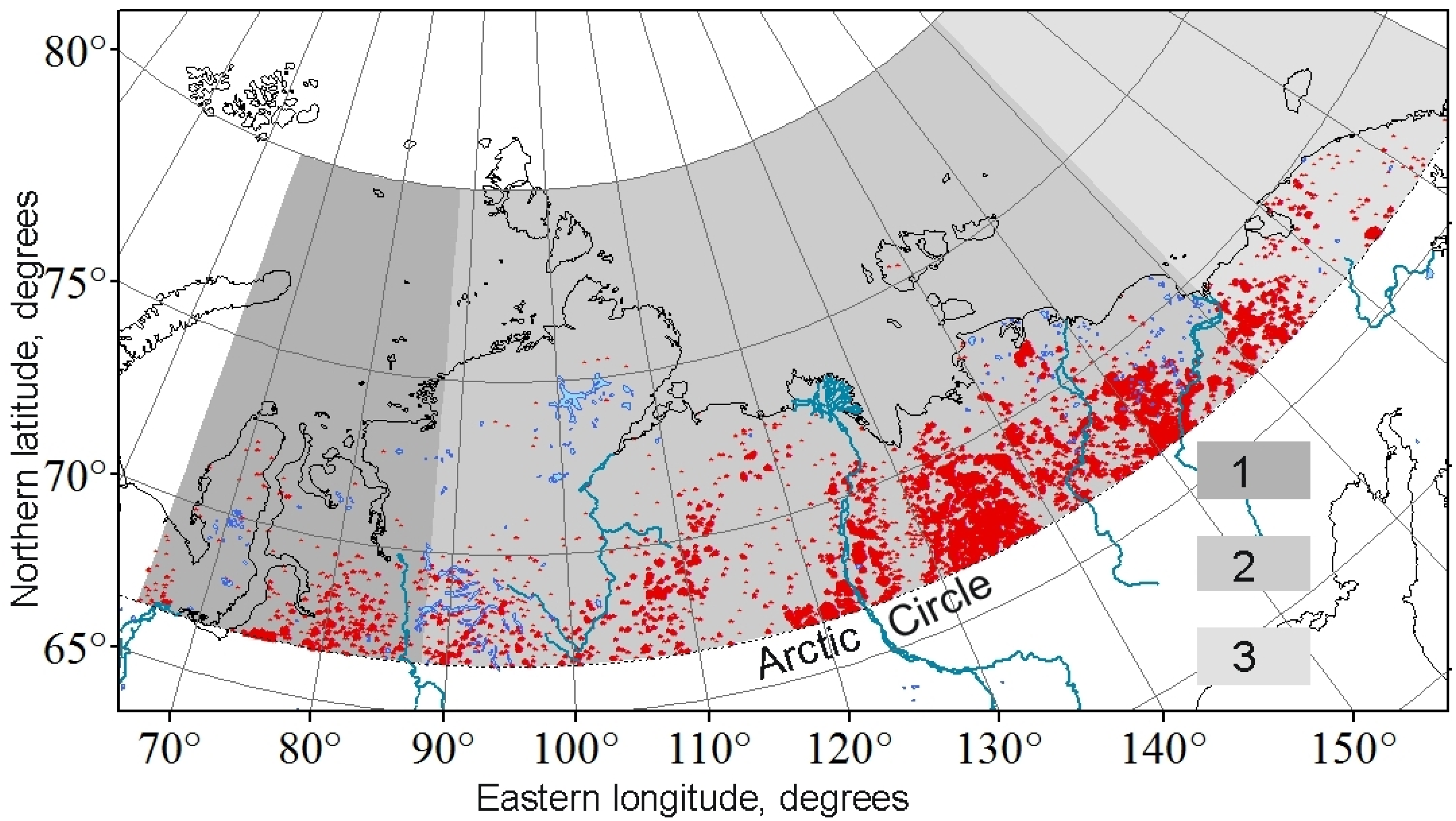
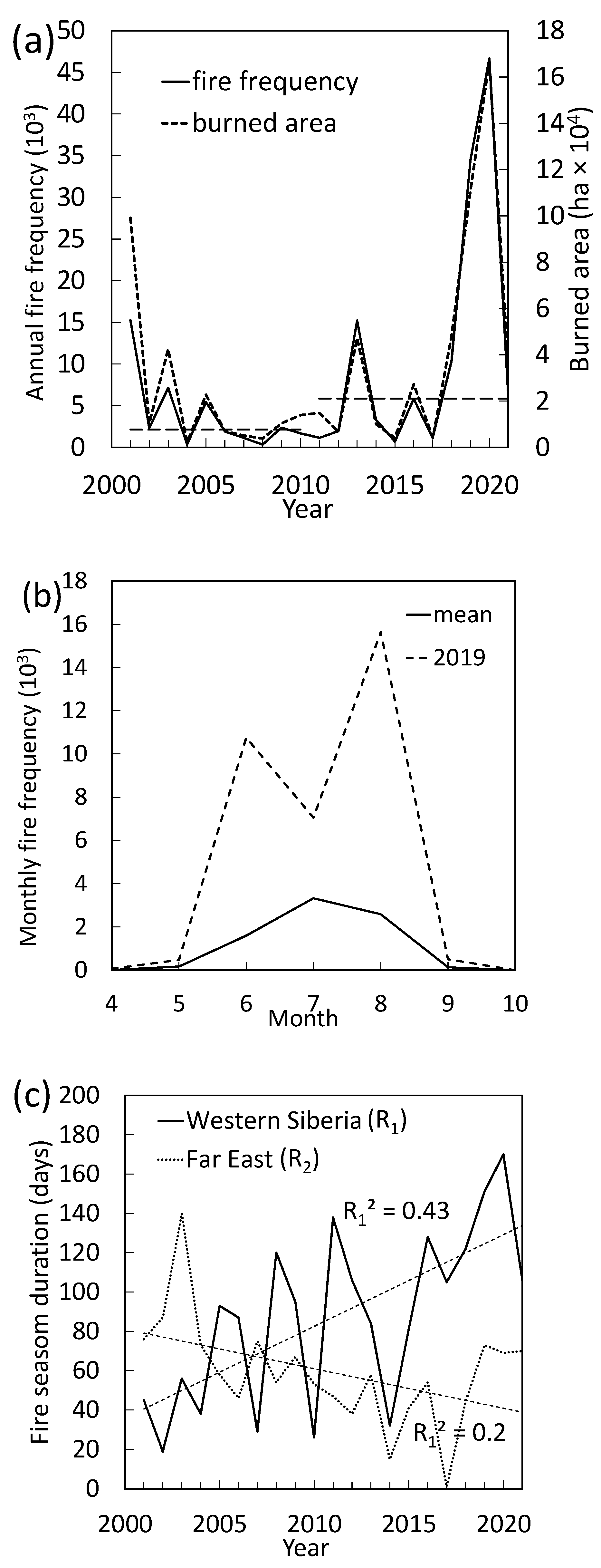
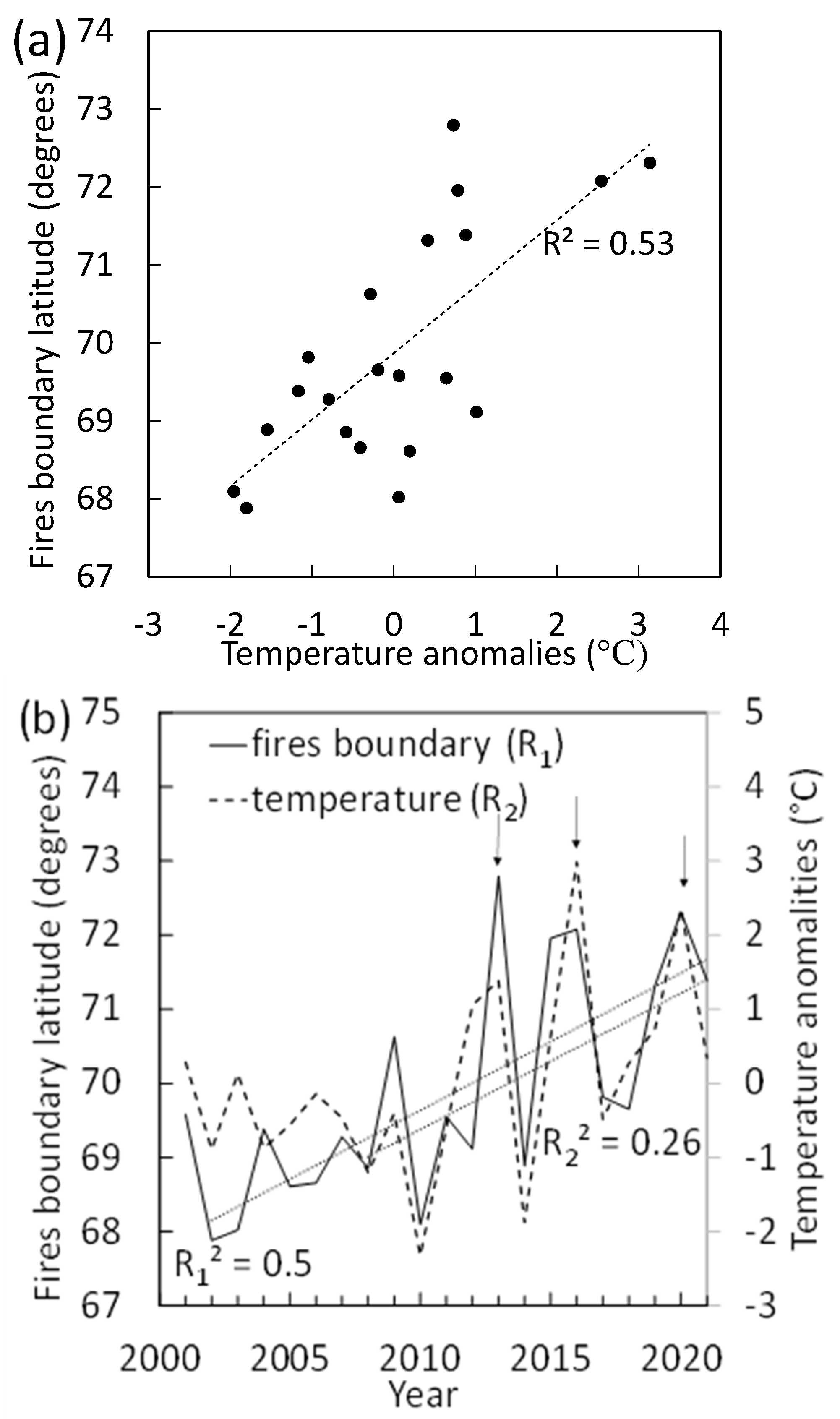
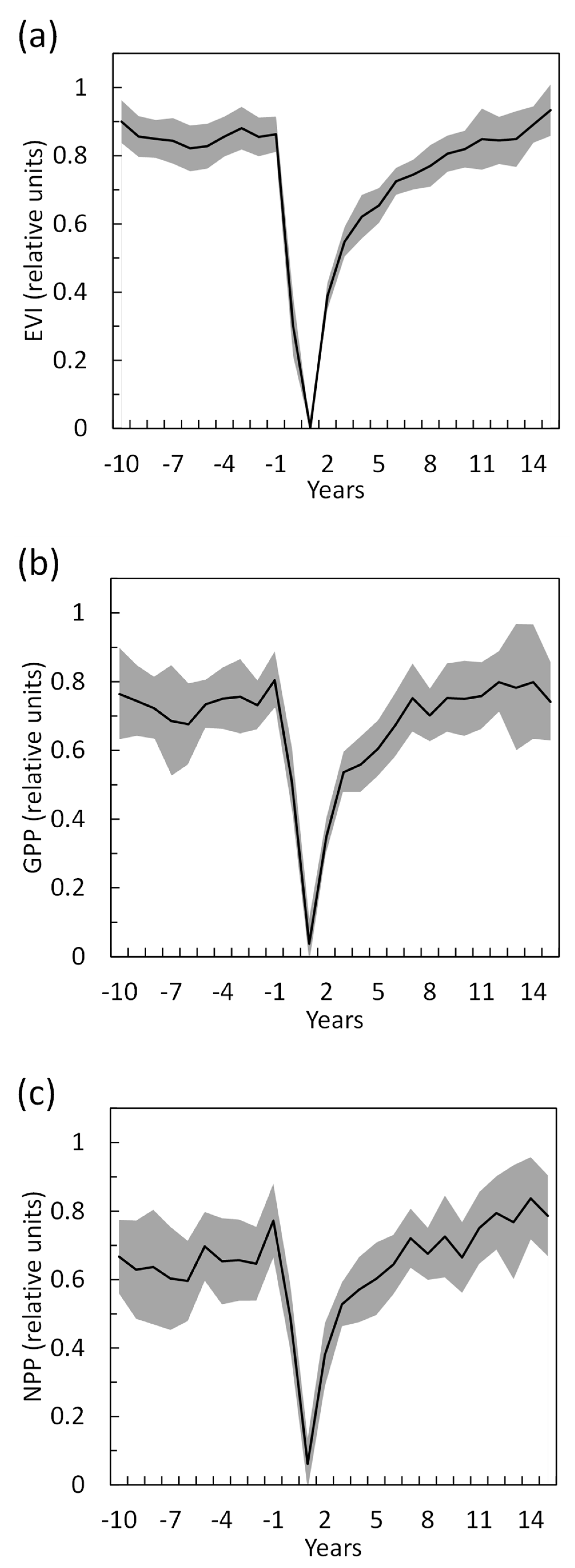
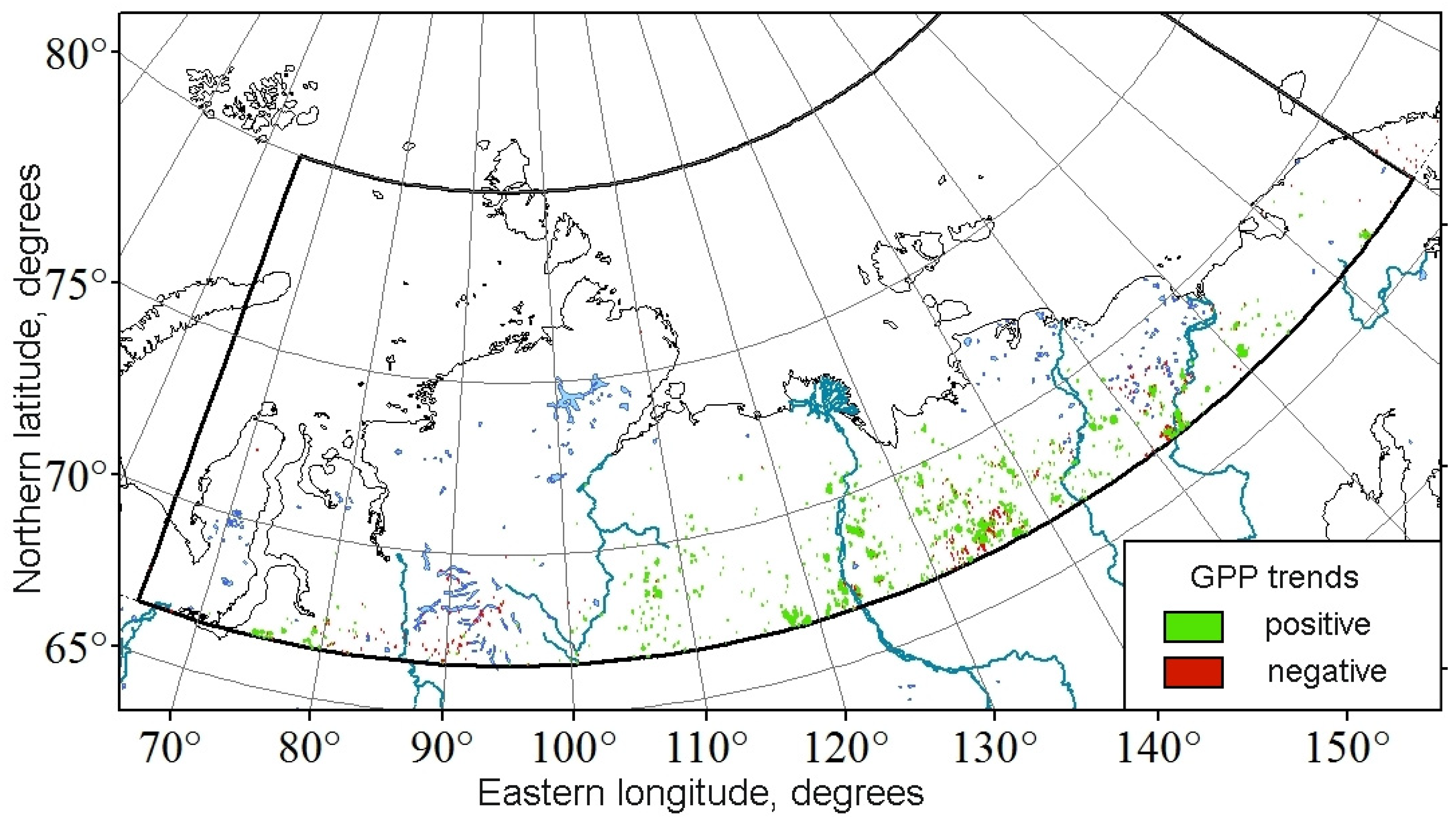
| Parameter | Whole Siberian Arctic | Western Siberia Sector | Eastern Siberia Sector | Far East Sector |
|---|---|---|---|---|
| Fire frequency ratio | 2.8 | 2.3 * | 2.1 | 1.1 |
| Burnt area extent ratio | 2.6 | 3.5 ** | 2.5 | 0.5 |
| Fire season duration (days) | 18.0 ** | 36.5 ** | 8.5 | −19.0* |
| Onset of fire season (days) | −6.0 | −23.0 ** | −5.0 | 6.5 |
| Conclusion of fire season (days) | 11.5 | 18.5 * | 1.0 | −15.5 |
| Northern fire boundary shift (degrees of latitude) | 0.0 | 2.6 ** | −0.4 | 0.1 |
| Variables | Whole Siberian Arctic | Western Siberia Sector | Eastern Siberia Sector | Far East Sector |
|---|---|---|---|---|
| Annual Fire Frequency | ||||
| Air temperature (June–August) | 0.66 ** | 0.41 * | 0.68 ** | 0.39 * |
| Precipitations (June–August) | −0.56 ** | −0.38 * | −0.53 ** | −0.36 |
| Ground cover moisture (May–September) | −0.82 ** | −0.46 ** | −0.84 ** | −0.50 ** |
| SPEI B (May–September) | −0.68 ** | −0.42 * | −0.70 ** | −0.50 ** |
| Burnt area extent | ||||
| Air temperature (June–August) | 0.70 ** | 0.43 * | 0.68 ** | 0.27 |
| Precipitations (June–August) | −0.49 ** | −0.27 | −0.44 ** | −0.15 |
| Ground cover moisture (May–September) | −0.76 ** | −0.34 | −0.78 ** | −0.49 ** |
| SPEI B (May–September) | −0.59 ** | −0.56 ** | −0.62 ** | −0.56 ** |
| Fire season duration | ||||
| Air temperature (May–September) | 0.41 * | 0.72 ** | 0.19 | 0.28 |
| Precipitations (June–August) | −0.47 ** | −0.22 | −0.32 | −0.39 * |
| Ground cover moisture (May–September) | −0.48 ** | −0.50 ** | −0.43 ** | −0.61 ** |
| SPEI B (May–September) | −0.09 | −0.10 | −0.25 | −0.62 ** |
| Northern boundary | ||||
| Air temperature (May–September) | 0.41 * | 0.65 ** | 0.38 * | 0.18 |
| Precipitations (June–August) | −0.26 | −0.25 | −0.36 | −0.37 * |
| Ground cover moisture (May–September) | −0.28 | −0.42 ** | −0.32 | −0.33 |
| SPEI B (May–September) | −0.68 ** | −0.27 | −0.62 ** | −0.15 |
| Onset date | ||||
| Air temperature (May–June) | −0.41 * | −0.59 ** | −0.32 | −0.23 |
| Final date | ||||
| Air temperature (August–September) | 0.29 | 0.58 ** | 0.11 | 0.09 |
Publisher’s Note: MDPI stays neutral with regard to jurisdictional claims in published maps and institutional affiliations. |
© 2022 by the authors. Licensee MDPI, Basel, Switzerland. This article is an open access article distributed under the terms and conditions of the Creative Commons Attribution (CC BY) license (https://creativecommons.org/licenses/by/4.0/).
Share and Cite
Kharuk, V.I.; Dvinskaya, M.L.; Im, S.T.; Golyukov, A.S.; Smith, K.T. Wildfires in the Siberian Arctic. Fire 2022, 5, 106. https://doi.org/10.3390/fire5040106
Kharuk VI, Dvinskaya ML, Im ST, Golyukov AS, Smith KT. Wildfires in the Siberian Arctic. Fire. 2022; 5(4):106. https://doi.org/10.3390/fire5040106
Chicago/Turabian StyleKharuk, Viacheslav I., Maria L. Dvinskaya, Sergei T. Im, Alexei S. Golyukov, and Kevin T. Smith. 2022. "Wildfires in the Siberian Arctic" Fire 5, no. 4: 106. https://doi.org/10.3390/fire5040106
APA StyleKharuk, V. I., Dvinskaya, M. L., Im, S. T., Golyukov, A. S., & Smith, K. T. (2022). Wildfires in the Siberian Arctic. Fire, 5(4), 106. https://doi.org/10.3390/fire5040106








